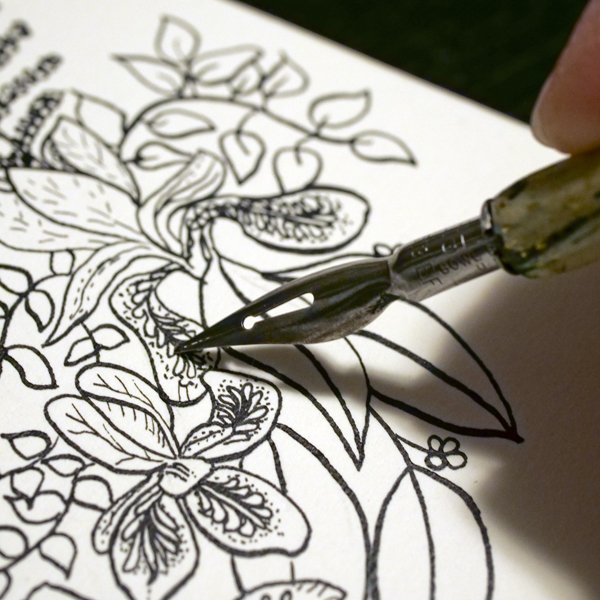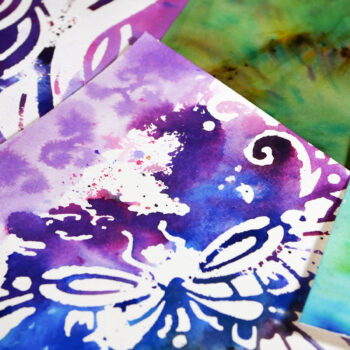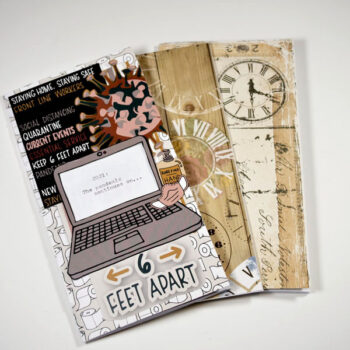
How to Use a Dip Pen
As this month is Inktober, I wanted to share with you about how to use a dip pen. Using a dip pen is one of the skills that I have learned this year and it has had a huge impact on how I draw and how I approach drawing.
Using a Dip Pen
With all the different pens out on the market, many of us think of dip pens as a tool only used in calligraphy. Since I started working with a dip pen, I have started to use it in many art mediums, especially in my art journal. In the video below, I demonstrate how I get good strokes, what nibs I use, and how I incorporate the dip pen into my drawing.
What is a Dip Pen?
A dip pen is basically a metal nib attached to a pen holder. The pen holder has small teeth that holds the nib in place. It is a friction fit so that your nib does not move, but this makes it easy to change nibs in your pen holder. When you are adding your nib to a dip pen holder, you do not have to push it all the way in. Press it in far enough that the nib is seated, feels stable and does not move with your strokes.
What to Look for in a Pen Holder?
What do you need to look for in a pen holder? Start by finding a pen holder that fits comfortably in your hand. There are many different finishes and styles but if the teeth are strong and it has a comfortable fit, you have a pen holder that will help your creative practice. The difference between a cheap and expensive pen holder often comes down to the materials they are made of.
Dip Pen Nibs
There are a variety of dip pen nibs from a few different companies. I have nibs from Speedball, Brause and Joseph Gilliott.
A few years ago, I bought a super cheap dip pen set that came with a handle and 5 nibs. The handle was uncomfortable, the nibs did not hold ink properly and after a few attempts to use the pen, I decided that a dip pen was not for me.
Earlier this year I was taking a class on Illuminated Lettering which required me to purchase a dip pen and specific nibs for the class. This is when I went to my local art store and bought a better dip pen holder and the nibs that were recommended by the instructor. What a difference it made! By having the right nibs, instead of feeling frustrated with learning how to use a dip pen, I realized that I needed to start with good quality tools.
Having good quality nibs can make all the difference in your work. Most of the nibs that I bought are between $2.50 and $6 CAD per nib. In the big scheme of things, they are not nearly as expensive as most of my other art supplies. Because I am using higher quality nibs, I am also getting better results.
Writing Nibs
I have a few larger nibs that I use for general drawing and writing. They have big bowls so they hold a fair amount of ink in them. This is nice because I can write for a while before having to dip in again. What is also nice about these nibs is that if you press harder, you can get thick lines, while pressing softer can give you get very thin, detailed lines. I have often used these writing nibs to do a full art piece. Instead of having 6 or 8 pens of different thicknesses, by using a dip pen, it allows me get a lot of variety in my work. It just takes a little bit of practice and time.
Filigree and Retouching Nibs
I also have some fine nibs for retouching projects and doing filigree work. They are very fine nibs and require re-inking often. They are meant for detailed work and for retouching lines.
Other Nibs
I also have some other nibs including a thick chisel nib. This is often used when I want to do bold capital letters and want to get a fair amount of ink down on paper. I also have a 5-pronged nib that is used for creating musical staff paper. What is unique about this nib is with the 5 prongs it allows for some unique patterns and shapes. I found these two nibs at my local art store, when I asked for some unusual nibs to try.
Inks
I have three inks that I enjoy using the most in my dip pen work. These are Speedball Super Black India Ink, Dr. P.H. Martin’s Pen White, and Winsor and Newton Gold Metallic Bronze.
Speedball Super Black India Ink
The Speedball Super Black India Ink I found when researching a good quality waterproof black ink. I like practicing with my dip pen, but I also love using watercolor in my drawings. This India ink is waterproof, works well with watercolor paint and I love the consistency of the ink.
Dr. P.H. Martin’s Pen White
If you enjoy drawing or inking on dark surfaces the Dr. P.H. Martin’s Pen White is my favorite white ink. This ink was recommended to me by a professional calligrapher for the trueness of the white pigment and how well it works on projects. One thing I have learned from using this ink is that it does need to be watered down a bit. I find it thicker than what I enjoy using with my pen, so I decant a small amount of ink and add a little water to give it a consistency that works best for me.
Winsor and Newton Gold Metallic Bronze
The Winsor and Newton Gold Metallic Bronze is my favorite ink because of the color and shine. It works beautifully for illuminated lettering and adds beautiful accents to my work. The important thing with this ink is to keep it well mixed by shaking it often as you work.
Dip Pen Strokes
As I continue to work on my pen skills, I have picked up a few tricks for making good dip pen strokes. If you are new to using a dip pen, start with a larger nib with a larger bowl. The larger nib carries more ink and allows you to draw longer between dipping. This will make the learning curve a little bit easier.
When you dip your pen into the ink, you will often have more ink than the pen can hold. I usually hold mine vertically to let a bit of the ink drip off. I then gently draw the nib across the top of my ink well. This will take off any excess ink that may drop in blobs on your project. Lastly, I usually take a few strokes on a scrap piece of paper to get the ink flowing and to make sure that I don’t have too much ink on my nib. To see the full demonstration, please reference the video above.
Using a Dip Pen and Self-Care
You might be wondering what is the connection between using a dip pen and self care? I love using my dip pen for two reasons. One, it forces me to slow down. By take pauses as I work, it allows me to be more purposeful with my strokes. I feel that it is a great mindfulness activity.
It also helps me to loosen up my artwork. I struggle to keep a loose grip and loose strokes as I draw. When using a dip pen, there is a lot of freedom as you draw with it. Dip pens are often used with a very purposeful style requiring extreme detail. By using a looser stroke, this allows for a more relaxed way of using your dip pen and very interesting mark making.
How About You?
Have you ever played with a dip pen before or is this the first time you have read about how to use a dip pen? I would love to hear about your experience with it and what you have learned. Please comment below or contact me directly. I hope that you try using a dip pen in your art, it is a very rewarding practice!





